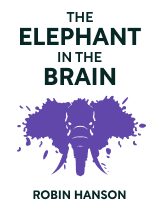

This article is an excerpt from the Shortform book guide to "The Elephant in the Brain" by Robin Hanson and Kevin Simler. Shortform has the world's best summaries and analyses of books you should be reading.
Like this article? Sign up for a free trial here .
Why do people donate to charity? Do they truly care about the cause—or just how they look to others?
In The Elephant in the Brain, Kevin Simler and Robin Hanson argue that charity isn’t just about helping others—it’s also about showing off how compassionate and benevolent you are. This is part of their general argument that human behavior is driven by selfish motives.
Continue reading to learn more about this theory.
Selfish Giving
Why do people donate to charity? At least part of the reason is social signaling. Just as body language allows us to communicate about things we’d never put into words, Simler and Hansen argue that many of our actions double as conspicuous fitness displays—they say to a potential mate, ally, or enemy: “Look how strong, wealthy, powerful, and connected I am.” This is especially noticeable when it comes to how we spend our money and other resources.
Simler and Hanson point out that most people don’t pay attention to how efficiently charities use their donations. They argue that charities that have been shown to use donations the most effectively remain less popular than ones that have better name recognition—regardless of how objectively effective these better-known charities are. For example, they point out that the Against Malaria Foundation—which has been ranked as one of the most effective charities—is less popular than, say, the United Way. They suggest that one reason for this is that we know others will recognize the United Way and are therefore more likely to give us credit for donating there than they would with a more obscure—but possibly more effective—charity.
The authors also argue that giving is affected by visibility and peer pressure. For example, they point out that people are more likely to give when solicited to do so by an attractive member of the sex they’re interested in—suggesting a desire to signal favorable qualities.
(Shortform note: Taming the elephant: If you want to make your giving more beneficial—even if that means it might be less visible—it’s worth investigating the effective altruism movement (which Simler and Hanson mention in the book). The idea of effective altruism is to use objective data to figure out which charities and causes do the most good per dollar spent. In general, effective causes are those that affect many lives, are currently neglected, and can be dramatically improved by money or other resources.)

———End of Preview———
Like what you just read? Read the rest of the world's best book summary and analysis of Robin Hanson and Kevin Simler's "The Elephant in the Brain" at Shortform .
Here's what you'll find in our full The Elephant in the Brain summary :
- How human behavior is driven by selfish motives
- Why your own brain is hiding your intentions from you
- Why the purpose of education is to certify future employees






